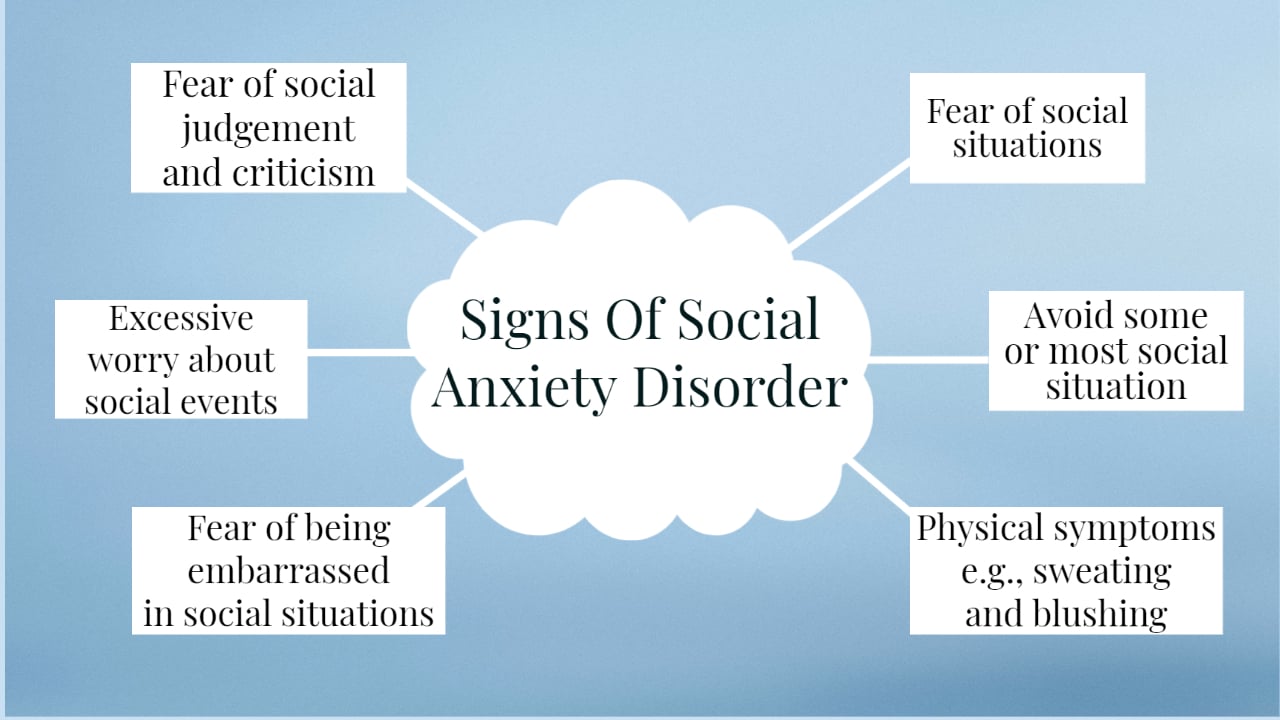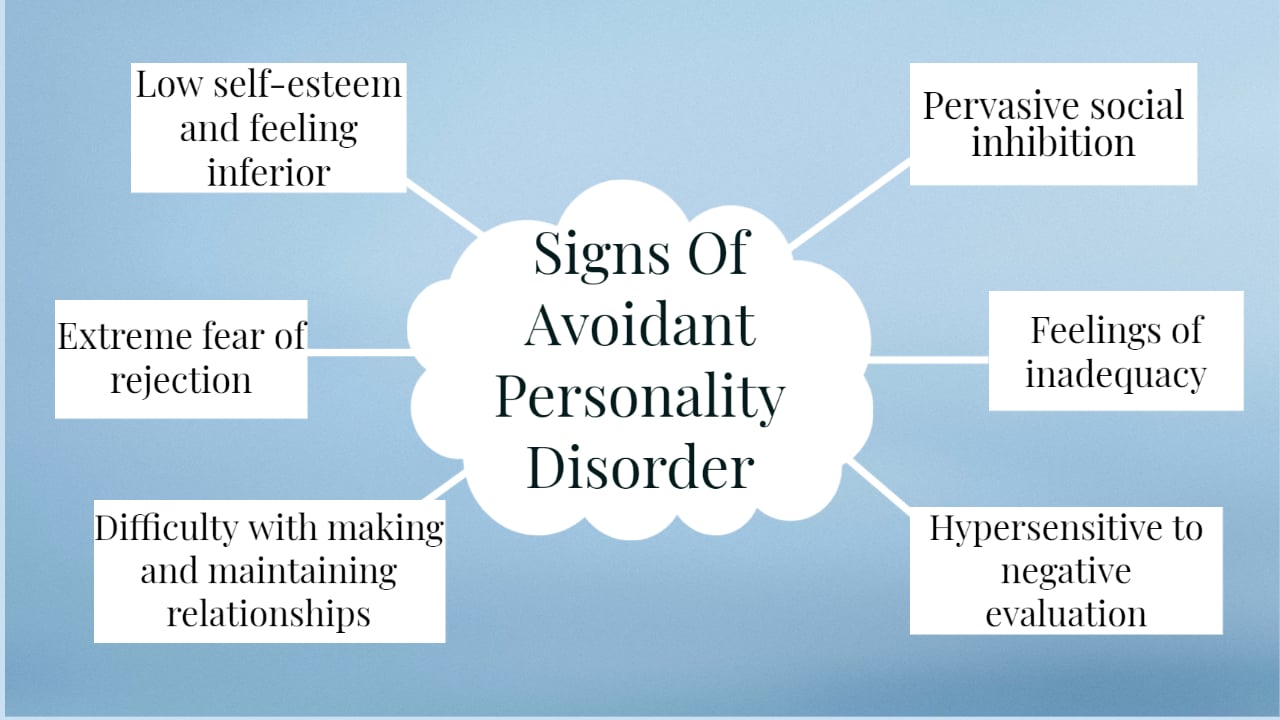On This Page:
Although Avoidant Personality Disorder (AVPD) and Social Anxiety Disorder (SAD) share some similarities, they are distinct conditions.
SAD is characterized by excessive fear or anxiety in social situations, while AVPD involves a pervasive fear of rejection, criticism, or disapproval and avoidance of social situations.
While someone with SAD may feel comfortable in non-threatening social situations, those with AVPD may avoid all social interaction.
It’s important to note that individuals can have both conditions simultaneously, but a proper diagnosis is crucial for effective treatment. Seeking professional help and support can make a significant difference in managing these conditions and improving overall quality of life.
| Avoidant Personality Disorder | Social Anxiety Disorder |
|---|---|
| Pervasive pattern in many areas of life | Specific to social situations |
| Social inhibition, feelings of inadequacy, hypersensitivity to negative evaluation | Intense fear or anxiety in social situations, fear of embarrassment or judgment |
| Broader range of interpersonal relationships and self-perceptions | Fear of scrutiny in social situations |

What is Social Anxiety disorder?

Social anxiety disorder (SAD) is an intense, long-standing, and debilitating fear of social situations.
Some situations that may be fearful to someone with SAD include public speaking, one-on-one conversations, making phone calls, and attending social gatherings.
Someone with SAD often fears that they will embarrass themselves or be negatively judged and criticized by others in social situations.
They may experience intense anxiety during one or more social situations, fear talking to others, and often avoid situations where their social anxiety can worsen.
People with SAD also experience a lot of physical sensations when in fearful social settings, such as blushing, sweating, muscle tension, and breathlessness.
Anxiety in response to a social situation can occur before, during, or after a social situation, with many experiencing anxiety throughout.
SAD can manifest in a variety of ways, with some individuals experiencing heightened anxiety in most social situations while others may only experience it in specific settings. Each person’s social fears and triggers are unique and may vary in severity. It’s important to note that experiencing a few symptoms of SAD does not necessarily indicate a diagnosis.
What is Avoidant Personality Disorder?

Avoidant Personality Disorder (AVPD) is a mental health condition characterized by a pervasive pattern of social inhibition, feelings of inadequacy, and hypersensitivity to negative evaluation.
AVPD is considered a cluster C personality disorder. Personality disorders are a specific kind of mental health issue where patterns of thought and behavior affect daily life.
Those with personality disorders often experience difficulty in their professional and personal life since they have difficulty understanding other people and common situations.
People with AVPD may also have low self-esteem and feelings of inferiority, as well as a tendency to view themselves as socially inept or unappealing. They may have hypersensitivity to criticism and constant fear of rejection.
They will usually try to avoid any and all social interactions as much as they can, only interacting with people they strongly believe will not reject them. They are also more likely to isolate themselves purposely.
Those with AVPD often want and even crave social connection, but their disorder keeps them from being able to participate in healthy social interactions.
It is worth noting that AVPD can present differently in everyone. The specific fears and triggers that individuals with AVPD experience can be unique and may vary in severity. Many people may identify with one or more symptoms of the disorder but may not qualify for a full diagnosis.
Unlike normal social shyness, the fears experienced by those with AVPD are persistent, pervasive, and often significantly impair daily functioning. It is essential to understand that experiencing a few symptoms of AVPD does not necessarily indicate a diagnosis.
Can you have both AVPD and SAD?
It was originally thought that AVPD only occurred in association with SAD. However, it is now believed that AVPD can occur in the absence of SAD.
That being said, around one-third of those with AVPD are also diagnosed with SAD. SAD is also thought to be the most common co-occurring condition in those with AVPD, with a study finding that as many as 48% of those diagnosed with AVPD also met the criteria for SAD (Hummelen et al., 2007).
Similarities between AVPD and SAD
There is debate over whether AVPD is a more severe type of SAD. Often, they are diagnosed together and can overlap in symptoms.
Both disorders can involve an intense fear of being embarrassed or judged in social situations. Both may present someone as shy, awkward, or fearful and demonstrate similar behaviors such as avoiding social situations, avoiding interaction with strangers, and socially isolating themselves from others.
What is the difference between social anxiety disorder and avoidant personality disorder?
While AVPD typically involves patterns of avoidance in most or all areas of life, SAD may only involve avoidance in a few specific social situations. Therefore, the Diagnostic and Statistical Manual of Mental Disorders (DSM-5) continues to categorize them separately.
Below is a table outlining some of the differences in symptoms. It is worth noting that the symptoms and impact can vary widely among individuals. This table is intended as a general guide to some of the key differences between the two disorders.
Avoidant personality disorder vs Social anxiety
| Trait | Social Anxiety Disorder (SAD) | Avoidant Personality Disorder (AVPD) |
|---|---|---|
| Fear and Anxiety | Excessive fear and anxiety in social situations, such as public speaking or meeting new people. | Persistent fear and anxiety in social situations due to a perceived risk of rejection, criticism, or disapproval. |
| Triggers | Fear may be limited to specific social situations, such as performance or public speaking, or it can be present in most social situations. | Fear can be present in all social situations, leading to avoidance of them altogether. |
| Self-Perception | Self-consciousness, excessive worry about being judged or scrutinized by others, and fear of embarrassment or humiliation. But, they can still have healthy self-esteem. | Pervasive feelings of inadequacy, low self-esteem, and a deep-seated fear of rejection, criticism, or disapproval. |
| Physical Symptoms | Sweating, trembling, racing heartbeat, and blushing. | Avoidance of social situations, isolation, and physical symptoms such as nausea or tension headaches. |
| Impact on Daily Functioning | Can lead to avoidance of social situations or significant distress, which can impair daily functioning. | Can significantly impair daily functioning, leading to social isolation, difficulty forming close relationships, and decreased occupational or academic performance. |
Most of the differences between AVPD and SAD are in how debilitating the person’s symptoms are. Those with AVPD are thought to have higher levels of anxiety compared to those with SAD.
They are also more likely to socially isolate themselves and be less able to function and form relationships than people with SAD.
Those with SAD are more likely to put themselves into social situations despite feeling anxious as they are more likely to endure the anxiety, rather than those with AVPD who would find these situations too distressing and avoid them as much as possible.
People with AVPD would also be less likely to pursue jobs that require any kind of social interaction with others.
There are also differences in self-worth between those with AVPD and those with SAD. People with SAD can have healthy self-esteem and confidence despite their condition.
In contrast, people with AVPD have fundamental feelings of inadequacy and inferiority, which drives them towards extreme social inhibition as they seek to avoid rejection, embarrassment, and judgment.
The differences may lie in how a person views their own experience and perceives their fears. Those with SAD understand on a basic level that their anxiety is irrational and that the world doesn’t judge them as harshly as they judge themselves.
Those with AVPD, however, may lack this insight and hold deep-rooted feelings of insecurity and worthlessness that they believe is the truth. They are more likely to suffer strong feelings of shame and self-loathing, believing that they are socially inept.
Comparable to AVPD, those with SAD do not see themselves as inferior – aside from their social awkwardness, they may see themselves as equal to those without SAD.
Is AVPD More Than Social Avoidance?
While SAD typically involves patterns of avoidance in a few or most specific social situations, those with AVPD may avoid most or all social areas of life.
Although social avoidance is a defining feature of AVPD, some theorists posit that AVPD is characterized by a broader pattern of avoidance that extends beyond social situations.
Findings from a study have revealed that there are some associations between AVPD and emotional and novelty avoidance, as well as avoidance of various non-social events (Taylor et al., 2004).
Meaning that those with AVPD are likely to try to avoid certain emotional states as well as seek new experiences or try anything new.
Is AVPD An Anxiety Disorder?
Since there are similarities between the symptoms of SAD and AVPD, some researchers argue that AVPD should be re-classified as an anxiety disorder.
One of the most important differences between the conditions is their classification. A personality disorder (such as AVPD) is characterized by enduring patterns of thought, feeling, and behavior that deviate significantly from cultural and societal norms and expectations.
These patterns are pervasive and inflexible, and they typically manifest across multiple areas of an individual’s life, such as relationships, work, and social interactions.
Personality disorders are difficult to treat as personality traits tend to remain the same across a person’s life.
Anxiety disorders, however, are a group of disorders that lead people to feel debilitating anxiety, nervousness, or worry in certain social situations.
Psychotherapies, medications, or self-help methods can manage or treat anxiety disorders. This means that it is possible to overcome SAD.
Causes Of AVPD
The exact cause of avoidant personality disorder (AVPD) is unknown, but it is believed to be a combination of genetic, biological, and environmental factors.
Individuals with a family history of AVPD or other anxiety disorders may be more likely to develop the condition. Studies on twins have revealed that genetic factors account for about half of the variance in AVPD.
Environmental factors, such as childhood experiences of neglect, rejection, or abuse, may also contribute to the development of AVPD.
People diagnosed with AVPD often report high childhood physical and emotional abuse rates, which disrupts healthy psychological development and impairs the ability to form healthy attachments while simultaneously causing them to internalize criticism and shame.
Additionally, social and cultural factors such as a lack of social support or cultural norms that emphasize perfectionism and self-criticism may also play a role. Being socially isolated may also be a risk factor for developing AVPD.
Some other risk factors for developing AVPD can include personality traits such as being introverted, having high neuroticism, and having an aversion to risks. This is not to say that having certain personality traits means that someone will develop a personality disorder.
It’s important to note that while these factors may increase the risk of developing AVPD, not all individuals with these risk factors will develop the disorder.
Causes Of SAD
It is not known exactly what causes SAD, but it can be caused by a combination of factors, including genetics, brain chemistry, environmental factors, and life experiences.
Social anxiety disorder can be hereditary, meaning that it may run in families. Specifically, those with a parent or sibling with an anxiety disorder may be at a higher risk of developing SAD.
However, it could be that growing up in the same environment as a family member with anxiety teaches the individual anxious behaviors, which can put them at risk for developing SAD.
Childhood experiences, such as bullying or a traumatic event, may increase the risk of developing social anxiety disorder later in life. Growing up in a family or culture that places a high value on social performance or social status may also contribute to the development of social anxiety disorder.
SAD can be triggered or worsened by certain life events, such as starting a new job, moving to a new city, or experiencing a significant life change.
People with SAD may have an imbalance of certain chemicals in the brain, such as serotonin or dopamine, which can affect their mood and behavior.
It’s important to note that while these factors may increase the risk of developing SAD, not all individuals with these risk factors will develop the disorder.
How Can AVPD And SAD Be Treated?
Treatment for AVPD
The symptoms of AVPD itself can create significant barriers to treatment since therapy requires the very social interaction that the individual tries to avoid. It can also be very difficult to treat AVPD, especially if the individual has had the symptoms for a long time.
However, therapy may still be very helpful, but there may be some things to consider for those with AVPD seeking treatment:
- The program size – it may be that a smaller, intimate treatment program can help someone with AVPD feel more at ease and avoid being overwhelmed by social interaction.
- The type of therapist – it can be useful to look for a therapist who is knowledgeable about AVPD and compassionate and experienced with managing avoidance symptoms.
- Variations of therapies – those with AVPD may find that non-verbal therapies, such as art or music therapy, early in the treatment can offer the space to express themselves without the expectation of social interaction.
Approaches to treatment for those with AVPD should target the pervasive patterns of social inhibition, feelings of inadequacy, and hypersensitivity to negative evaluation.
It is thought that CBT and schema therapy may be promising treatment options to tackle this.
Likewise, group therapy can help people with AVPD learn how to develop relationship and communication skills in a safe space. No specific medications are used to treat AVPD, but antidepressants and anti-anxiety medication may help relieve some of the symptoms.
Treatment for SAD
Social anxiety is more treatable than AVPD and has been shown to respond well to a combination of medication and talking therapy.
Anti-anxiety medications such as benzodiazepines and antidepressants, specifically selective serotonin reuptake inhibitors (SSRIs), are known to be effective in treating some SAD symptoms.
CBT is the most common form of therapy for those with SAD. This is because CBT tackles the negative and unhelpful thoughts and behaviors of those with SAD.
These thoughts and behaviors can get challenged and reconstructed into healthier thoughts and behaviors with the therapist’s help. A technique in CBT is exposure therapy, which can help the person with SAD to gradually expose themselves to fearful social situations so that they become less fearful over time.
This technique can help those with SAD engage in the social situations they wish to be a part of, and it helps them challenge the idea that others will negatively judge them.
While therapies may be helpful for some individuals with SAD, it is not exclusively necessary for managing the symptoms. Some people may find that their own self-help methods can help them overcome their social fears.
References
Hummelen, B., Wilberg, T., Pedersen, G., & Karterud, S. (2007). The relationship between avoidant personality disorder and social phobia. Comprehensive psychiatry, 48(4), 348-356.
Lampe, L., & Malhi, G. S. (2018). Avoidant personality disorder: current insights. Psychology research and behavior management.
Taylor, C. T., Laposa, J. M., & Alden, L. E. (2004). Is avoidant personality disorder more than just social avoidance? Journal of personality disorders, 18(6), 571-594.
Weinbrecht, A., Schulze, L., Boettcher, J., & Renneberg, B. (2016). Avoidant personality disorder: a current review. Current psychiatry reports, 18(3), 1-8.

